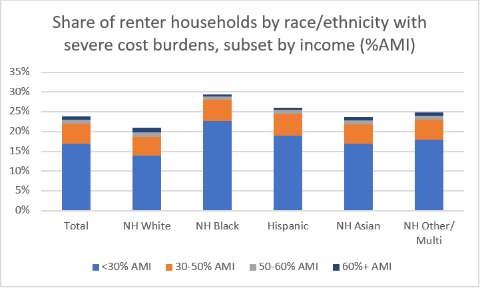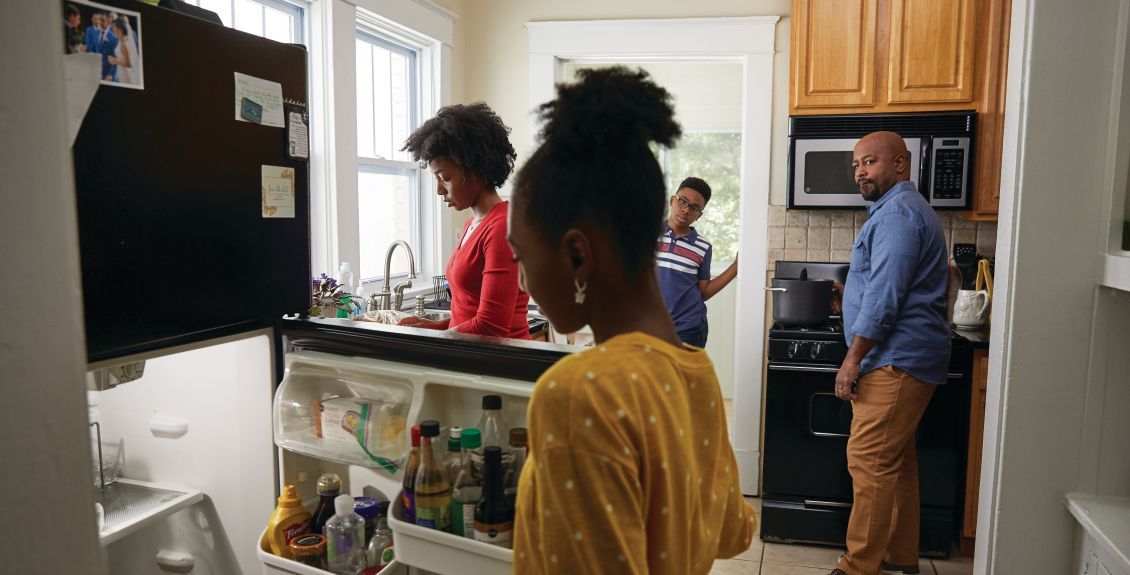During the American Heart Association’s November 12th community transformation roundtable, Jacqueline Waggoner, President of Enterprise’s Solutions Division, noted that when we fix our systems for Black Americans, we fix them for everyone, as Black people are disproportionality affected by inequities in our housing and health systems, among other systems. This is particularly true for Black renter households, who entered the Covid-19 pandemic already facing significant racial inequities in our housing system.
New analyses of recently released 2019 American Community Survey (ACS) data from the U.S. Census Bureau reveals how, even before the pandemic struck, lower-income Black households were the most likely to have housing affordability challenges. Starting out in such a disadvantaged position means these conditions are likely be exacerbated by pandemic-induced job losses—Black unemployment rates remain well above those of other workers—and the expiration of federal eviction protections and enhanced unemployment insurance benefits at the end of 2020, unless lawmakers provide additional emergency Covid-19 relief..
Black Renters Entered the Pandemic with Significant Housing Challenges.
Our analysis of the 2019 ACS data shows that 30 percent of Black renters were severely cost burdened last year, i.e., they spent more than half their income on housing (see figure 1). Moreover, most of these households also had extremely low incomes, earning less than 30 percent of their area median income (AMI). Indeed, nearly a quarter of all Black renter households were both severely cost burdened and had extremely low incomes. This share is the highest among any racial/ethnic group, and larger even than the share of all white renters who were severely cost burdened (21 percent)..

In addition, our analysis shows that lower incomes among Black renters fully explain their higher cost burden share. In 2019, Black and white renter households who earned incomes above 30 percent of their AMI had the same shares of severely cost burdened households, at 7 percent for each racial group in this income range.
Job Losses Have Exacerbated Black Renters’ Housing Instability Challenges
Since the pandemic’s economic fallout started significantly impacting the U.S. economy in the second quarter of 2020, Black workers have been disproportionately affected by pandemic-induced job losses. Between February and May 2020, the unemployment rate for Black workers increased from 5.8 percent to 16.8 percent, while unemployment among white workers only rose from 3.1 percent to 12.4 percent.
The latest job report from the U.S. Bureau of Labor Statistics, however, shows that though the unemployment rate for Black workers was down to 10.3 percent in November 2020, unemployment among white workers had also decreased to 5.9 percent as of last month. This means that while unemployment rates improved for both Black and white workers between the second and fourth quarters of 2020, the 4.4 percentage point gap between them has stubbornly remained in place. Furthermore, this uneven job recovery indicates that the pandemic-induced economic fallout has been hitting Black workers especially hard.
Job losses are especially troubling for Black renters who entered the pandemic with low incomes and significant housing affordability challenges. These conditions make Black renters with severe housing cost more vulnerable to housing insecurity and the risk of eviction, as they are more likely to rely on using earned income to pay rent and are less likely to stay current on their rent after experiencing job loss. Enterprise’s analysis of the 2019 ACS data finds that over 55 percent of Black renters with severe cost burdens had earned income, compared to 47 percent for severely cost burdened white renters. This means that any interruptions to severely cost burdened Black renters employment will significantly impact their ability to stay current on their rent.
Addressing Black Renters’ Housing Affordability and Instability Challenges
The pandemic-induced financial insecurity adds even more urgency to addressing the housing affordability challenges facing lower-income Black renters, particularly those with severe cost burdens. Providing additional emergency rental relief and extending and strengthening federal eviction protections are the first step to help Black renters with accrued rent arrearages stay at their homes and prevent an otherwise anticipated wave of new eviction cases in early 2021, when the current CDC eviction moratorium ends.
Such a wave would not only disproportionately harm Black renters and communities of color economically, but it would increase their already-higher risk of exposure to the coronavirus by forcing them to double-up in crowded households, live in congregate shelters, or even live unsheltered without the ability to practice virus mitigation measures. Emergency federal rental relief would thus not only provide much-needed rental aid and eviction protections, but it is essential for protecting public health and serving as a starting point for addressing racial equity post-pandemic and beyond.
